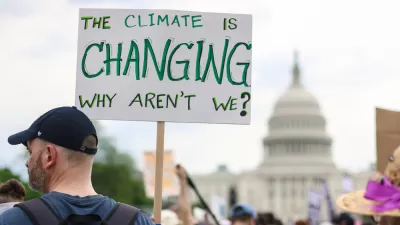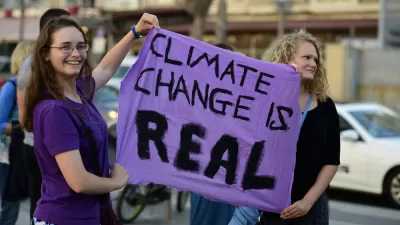The role of humans in creating immense risks from extreme weather, drought, sea-level rise, and bio-diversity loss is "unequivocal," according to a landmark study by the International Panel on Climate Change (IPCC).

The International Panel on Climate Change (IPCC) released it most recent climate assessment today, updating the state of knowledge on climate change and marshaling local and national resources around the world to take action to limit the risks presented by a changing climate.
The Sixth Assessment Report announced today was created by the IPCC's Working Group I, which analyzes the physical basis of climate change. The headlining statements from the Sixth Assessment declares "unequivocal" evidence for the role of human activity in unprecedented changes to the climate. Those changes are accelerating and are likely to worsen over the next 30 years, according to the report, and global warming of 1.5 to 2 degrees Celsius will be exceeded by the end of the century. The changes that will result, especially in the oceans and waters of the planet, could take many millennia to undo.
U.N. Secretary General António Guterres marked the publication of the Sixth Assessment by describing the findings as a "code red for humanity."
The Sixth Assessment follows seven years after the previous iteration of the assessment, was written by over 230 authors, citing more than 14,000 studies. The IPCC was created by the United Nations Environment Programme and the World Meteorological Organization in 1988. The IPCC now has 195 member countries and has been endorsed by the UN General Assembly.
The Sixth Assessment attracted major attention from media outlets all over the country today. Writing for The Washington Post, Brady Dennis and Sarah Kaplan write that the report emerges at a particular auspicious moment in climate change history:
Released amid a summer of deadly fires, floods and heat waves, it arrives less than three months before a critical summit this November in Scotland, where world leaders face mounting pressure to move more urgently to slow the Earth’s warming.
Despite the report's warnings, like those that came before, and despite all of the photographic evidence emerging all over the world, "the collective effort to slow climate change has proved gravely insufficient," according to Dennis and Kaplan. To keep the warming below 1.5 degrees Celsius by the end of the century, according to the Paris Climate Agreement, the world has a budget of 500 additional gigatons of carbon dioxide—about what humans currently produce every ten years. The Sixth Assessment would seem to indicate that the threshold set by the Paris Climate Agreement is approaching more rapidly than previously estimated.
"The world has already warmed more than 1 degree Celsius (1.8 degrees Fahrenheit), with few signs of slowing, and could pass the 1.5-degree mark early in the 2030s," write Dennis and Kaplan.
Writing for The New York Times, Brad Plumer and Henry Fountain note the actions still possible for mitigating the worst effects of climate change—even if the window for action is rapidly closing.
"Doing so would require a coordinated effort among countries to stop adding carbon dioxide to the atmosphere by around 2050, which would entail a rapid shift away from fossil fuels starting immediately, as well as potentially removing vast amounts of carbon from the air," write Plumer and Fountain.
If nations follow through on more recent promises — like Mr. Biden’s April pledge to eliminate America’s net carbon emissions by 2050 or China’s vow to become carbon neutral by 2060 — then something closer to 2 degrees Celsius of warming might be possible. Additional action, such as sharply reducing methane emissions from agriculture and oil and gas drilling, could help limit warming below that level.
Though the political control wielded by the entrenched interests of corporations and property owners still seems insurmountable in the United States, planners are uniquely positioned on the front lines of transportation, land use, and infrastructure policy making and project implementation to protest the status quo and redirect the country's future toward the economic and cultural changes and aggressive timeline that will be necessary to mitigate the effects of climate change.
Beyond the access planners have to the processes and projects that produce the emissions that cause the climate change, we all need to do, and can still do, more to prevent the worst of climate change—a fact that might be lost in the dire pronouncements of the clickbaity headlines that briefly filled the country's airwaves today. Much of the response on Twitter indicated alarm at the kind of defeatist attitude present in the news coverage of the new report, appealing for more action from political leaders, corporations, and the general public.
There are those who have recommendations for how to get started making a difference toward emissions reductions. "If you have ever thought of becoming more involved in the fight for climate justice, it’s time to stop thinking, and start doing," writes Emily Atkin in an article written in July, after a draft of the Sixth Assessment was leaked to the Agence France-Presse. Atkin writes specifically to the actions ncessary to respond to the details of the latest IPCC report. There is plenty to be optimistic, according to Atkin, because just as our scientific understanding of climate change has increased, so to has our knowledge of how to curb emissions and mitigate climate change.

Trump Administration Could Effectively End Housing Voucher Program
Federal officials are eyeing major cuts to the Section 8 program that helps millions of low-income households pay rent.

Planetizen Federal Action Tracker
A weekly monitor of how Trump’s orders and actions are impacting planners and planning in America.

Ken Jennings Launches Transit Web Series
The Jeopardy champ wants you to ride public transit.

Washington Legislature Passes Rent Increase Cap
A bill that caps rent increases at 7 percent plus inflation is headed to the governor’s desk.

From Planning to Action: How LA County Is Rethinking Climate Resilience
Chief Sustainability Officer Rita Kampalath outlines the County’s shift from planning to implementation in its climate resilience efforts, emphasizing cross-departmental coordination, updated recovery strategies, and the need for flexible funding.

New Mexico Aging Department Commits to Helping Seniors Age ‘In Place’ and ‘Autonomously’ in New Draft Plan
As New Mexico’s population of seniors continues to grow, the state’s aging department is proposing expanded initiatives to help seniors maintain their autonomy while also supporting family caregivers.
Urban Design for Planners 1: Software Tools
This six-course series explores essential urban design concepts using open source software and equips planners with the tools they need to participate fully in the urban design process.
Planning for Universal Design
Learn the tools for implementing Universal Design in planning regulations.
Heyer Gruel & Associates PA
Ada County Highway District
Institute for Housing and Urban Development Studies (IHS)
City of Grandview
Harvard GSD Executive Education
Toledo-Lucas County Plan Commissions
Salt Lake City
NYU Wagner Graduate School of Public Service






























